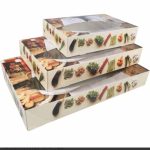
In an era where consumers are increasingly conscious about what they put into their bodies, food safety extends far beyond the ingredients list. The silent guardian standing between your food and potential contamination is often overlooked—the humble packaging box. Food-grade packaging boxes represent a remarkable fusion of science, sustainability, and consumer protection that’s transforming how we store, transport, and consume our daily sustenance.
What exactly makes packaging “food-grade”? This isn’t simply about cardboard or plastic containers. Food-grade packaging undergoes rigorous testing and certification processes to ensure it contains no harmful chemicals that could migrate into food products. These materials are specifically engineered to be inert, meaning they won’t react with the food they contain, preserving both flavor and safety. From the inks used for printing to the adhesives that hold boxes together, every component must meet stringent regulatory standards.
The evolution of food-grade packaging tells a fascinating story of innovation. Early food containers were primarily focused on basic protection from physical damage during transportation. Today’s food-grade boxes incorporate advanced features like moisture barriers, temperature resistance, and even smart indicators that change color when products approach expiration. The pharmaceutical and organic food industries have been particularly instrumental in driving these advancements, demanding packaging that maintains product integrity from manufacturing to consumption.
Sustainability has become an equally important consideration in food-grade packaging development. The modern consumer expects environmental responsibility alongside food safety. Manufacturers have responded with remarkable innovations—biodegradable coatings, plant-based plastics, and boxes made from recycled materials that still meet strict food safety standards. The circular economy model is gradually transforming packaging from a single-use item into a valuable resource that can be repurposed or composted, reducing the environmental footprint of our food consumption.
Beyond protection and sustainability, food-grade packaging plays a crucial role in brand storytelling and consumer education. The surface of these boxes serves as a canvas for nutritional information, cooking instructions, and brand values. Modern printing technologies allow for vibrant, detailed designs that capture consumer attention while maintaining complete food safety. This dual purpose—functional protection and marketing platform—makes food-grade packaging an essential element of product success in competitive markets.
The global pandemic highlighted another critical function of food-grade packaging: hygiene assurance. As consumers became increasingly concerned about surface transmission, properly sealed food-grade boxes provided visible evidence of product integrity. Tamper-evident features and secure seals became not just quality markers but essential consumer reassurance tools. This heightened awareness has permanently raised standards for what consumers expect from their food packaging.
Looking toward the future, food-grade packaging continues to evolve with emerging technologies. Active packaging that can absorb oxygen or release natural preservatives, intelligent packaging with QR codes that reveal detailed product journeys, and nanotechnology coatings that provide superior barrier properties—all while maintaining food-grade safety standards. The intersection of digital technology and material science promises even more sophisticated solutions that will further enhance food safety, reduce waste, and improve consumer experience.
For businesses in the food industry, investing in high-quality food-grade packaging is no longer optional—it’s a fundamental requirement for market access and consumer trust. The initial cost is quickly offset by reduced product loss, enhanced brand reputation, and compliance with increasingly strict food safety regulations. More importantly, it demonstrates a commitment to consumer wellbeing that modern customers have come to expect from responsible brands.
As consumers, we hold significant power in driving continued improvement in food packaging standards. By supporting companies that prioritize both safety and sustainability in their packaging choices, we collectively push the entire industry toward higher standards. The next time you unpack groceries or receive a food delivery, take a moment to appreciate the sophisticated engineering contained within that simple box—it represents years of research, innovation, and dedication to keeping our food safe, fresh, and delicious.




Leave a Message